Calculating the amount of material you need before starting a project is crucial for staying within budget. Start by using reliable quantity takeoff methods, whether manual or digital, to determine your material requirements. Keep in mind that prices can change and some materials may be hard to find, which can affect your costs. Conduct thorough site assessments and get input from experts for accurate estimates. Using technology can improve your precision and speed, giving you better insights into what you need. Consider ways to streamline your estimation process for even better results.
Key Takeaways
- Assess the site to understand the soil and rock conditions for accurate material needs.
- Take precise measurements to know exactly how much material you’ll require.
- Create clear architectural and engineering plans to guide your calculations.
- Use digital tools for quantity takeoffs to improve accuracy and minimize mistakes.
- Regularly update your estimates to account for changing material prices and market trends.
Understanding Material Costs
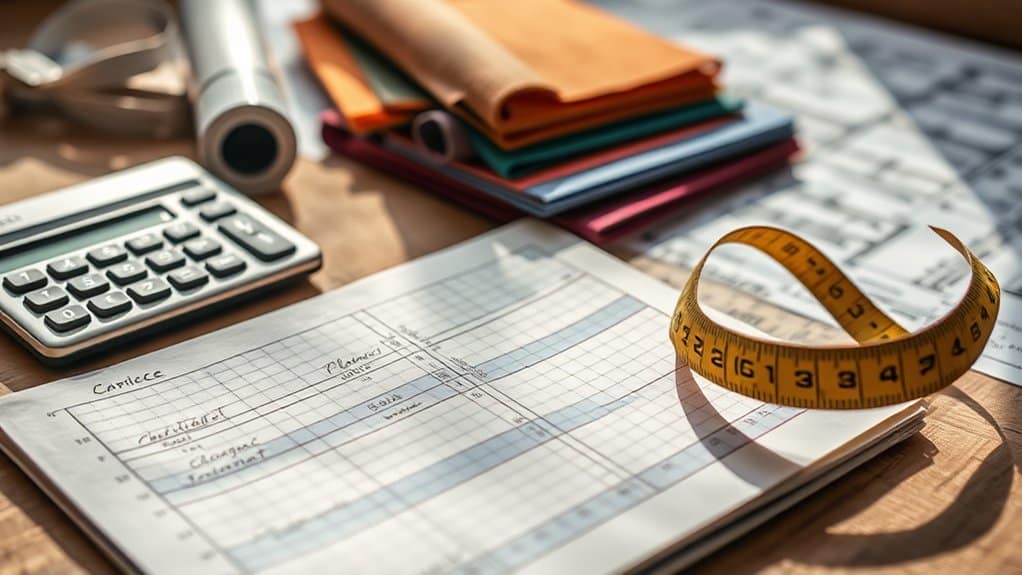
Understanding material costs is crucial for anyone in construction, as price fluctuations can significantly affect your budget. These changes often result from inflation, supply chain issues, and rising demand during economic growth.
For example, since 2020, more than 80% of construction materials have seen an average price increase of 19%. Moreover, limited availability of certain materials due to environmental regulations and global demand can drive prices up even further. Higher project costs lead to increased insurance premiums due to greater claims costs. Additionally, understanding cost factors related to specific materials can help you make informed purchasing decisions.
Staying informed about these factors helps you manage costs and reduce risks. By anticipating price changes, you can budget more accurately and remain competitive in your projects.
Quantity Takeoff Methods

There are several effective quantity takeoff methods that can improve your construction projects and accuracy. The elemental method divides your project into basic parts, like foundations and roofs, giving you a clear picture of material needs. The assembly method, on the other hand, focuses on functional units, such as walls or HVAC systems, ensuring you capture every detail for each section. Digital methods enhance efficiency by using software to reduce human error and work with Building Information Modeling tools. Quantity takeoffs are essential for effective budgeting, allowing you to mitigate the risk of cost overruns and optimize resource allocation.
Manual Quantity Takeoff
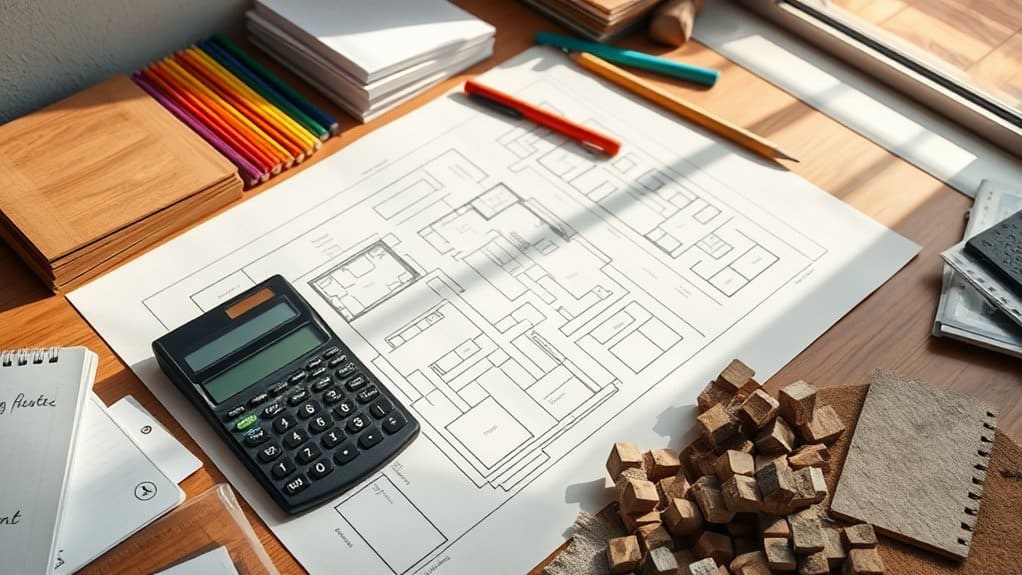
Manual quantity takeoff is still a key method in construction estimation, despite the rise of digital tools. This approach requires you to carefully review project drawings to count and measure materials, which can be time-consuming and prone to human error. However, it allows for precise budgeting and planning, helping you avoid costly delays and ensuring you have the right materials on hand. Using tools like scale rulers and tally counters can improve accuracy. Engaging in manual takeoff enhances your grasp of project details and helps you spot potential issues early. Accurate takeoffs are crucial for determining profit margins before quoting prices and help in tracking material costs throughout project changes, enhancing client satisfaction. Organizing your results in spreadsheets can further minimize mistakes and generate detailed reports.
Digital Quantity Takeoff
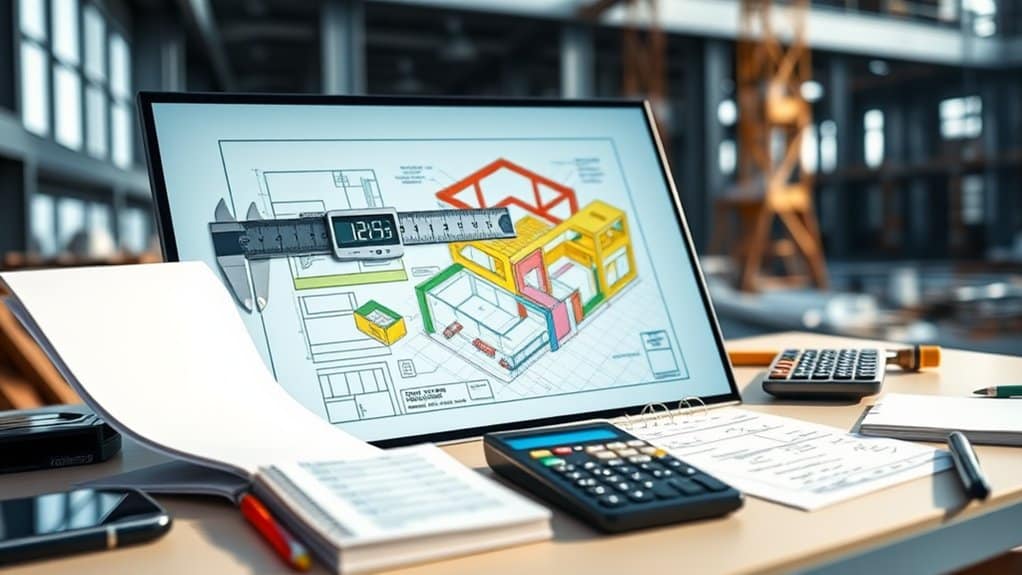
Digital quantity takeoff offers major benefits for your project workflow.
These tools boost accuracy in assessing materials and save time on calculations. For example, using software can cut down on manual errors, leading to more reliable estimates.
Software Benefits
Digital quantity takeoff software transforms the estimation process by automating tedious tasks, allowing teams to concentrate on what truly matters in a project.
Here are some key benefits of using this software:
- Speed: Automation significantly accelerates workflows.
- Resource Optimization: Accurate material counts help allocate resources effectively, minimizing waste.
- Cost Control: Precise estimates reduce the risk of budget overruns, improving financial management.
These advantages lead to more accurate bids and better teamwork.
With real-time updates and efficient workflows, you can meet tight deadlines and maintain project profitability.
Implementing digital takeoff tools boosts productivity and gives your firm a competitive advantage in the construction industry.
Improved Accuracy
Accurate material estimates are crucial for construction projects, impacting budgets, procurement, and schedules.
Digital quantity takeoff tools enhance accuracy by automating measurements and calculations, reducing human error. You can take precise measurements directly from digital plans, eliminating manual calculations.
These tools also promote collaboration, allowing teams to access the most accurate data in real-time, which streamlines the takeoff process. This leads to better cost control, less waste, and improved scheduling.
In short, accurate material estimates are the cornerstone of successful projects, helping to minimize financial risks and delays.
Common Materials Estimation
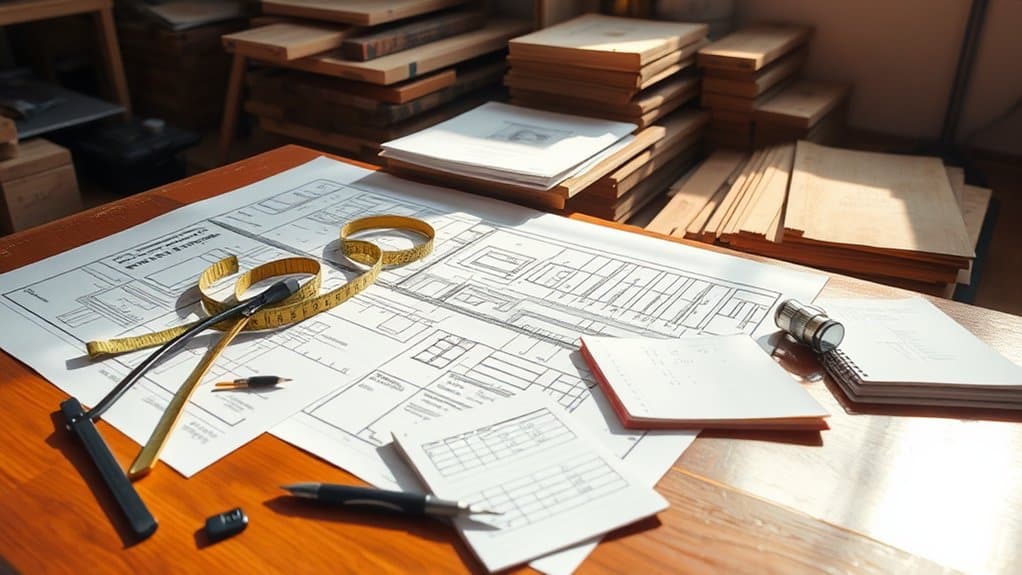
Accurate material estimation is crucial for any construction project. Here are some straightforward tips to help you:
- Lumber Calculations: Measure the height and length of your walls to figure out how many studs you need, including the top and bottom plates.
- Concrete Volume: For foundations or slabs, calculate the area in cubic feet and then convert that to cubic yards for your order.
- Software Tools: Use online calculators or takeoff software to improve precision and reduce mistakes.
Additionally, it is important to assess durability of the materials you plan to use to ensure they meet your project’s long-term needs.
These steps will help ensure your project stays on budget and schedule.
Strategies for Accurate Estimation

To get accurate material estimates, first, know your project dimensions and requirements inside out.
Using advanced software can make this easier and help you dodge typical mistakes. For example, if a wall size changes, updating your estimate right away keeps your project on track.
Regular updates ensure your estimates stay relevant throughout the project.
Understand Project Dimensions
Understanding project dimensions is crucial for accurate material estimation and effective planning. Here are some straightforward strategies to grasp project dimensions:
- Conduct thorough site assessments to pinpoint geological conditions and potential environmental risks. For example, knowing if the ground is rocky can impact your foundation choices.
- Develop clear architectural plans and engineering drawings to guide your estimates. This helps visualize the project and ensures nothing is overlooked.
- Use precise measurement techniques to determine the exact materials and quantities you’ll need, like measuring wall lengths to calculate paint or drywall requirements. Additionally, be aware of local laws that may dictate specific installation guidelines for your project.
Utilize Software Tools
Traditional material estimation can be slow and error-prone. Advanced software tools, like STACK Construction Software, simplify this process and improve accuracy. They automate takeoffs and use pre-built materials databases to minimize mistakes.
When integrated with financial management systems, these tools help keep budgets on track and provide real-time updates to the team, no matter where they are. Additionally, the software’s AI and machine learning features enhance estimation precision and allow for customized assemblies based on specific trades.
With user-friendly drag-and-drop functions and comprehensive reporting tools, you can efficiently manage projects and make informed decisions, leading to better resource allocation and successful outcomes.
Regularly Update Estimates
Regularly updating estimates is crucial for keeping your project on track, especially as circumstances evolve. Here are some straightforward strategies to revise your estimates effectively:
- Watch Market Trends: Track material prices to adjust your budget as needed. For instance, if lumber prices spike, factor that into your construction costs.
- Involve Your Team: Get input from team members regularly; they can provide insights that might change your estimates.
- Keep Records: Document every change you make. This not only builds trust but also helps everyone understand why adjustments were necessary. Additionally, consider consulting with contractors for accurate project cost estimates to ensure your estimates reflect current market conditions.
Utilizing Technology for Estimation
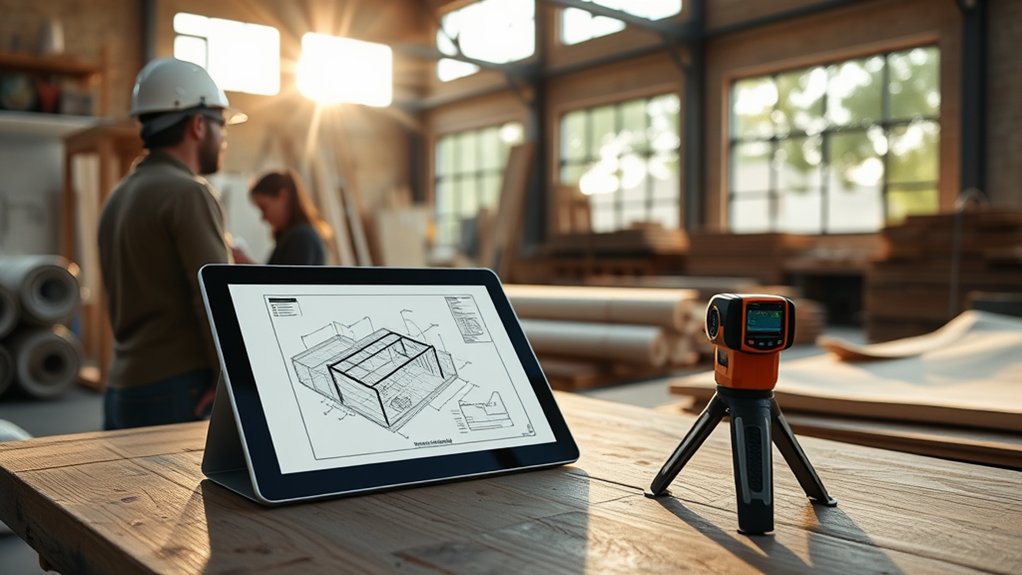
As construction projects grow more complex, using technology for estimation is crucial for accuracy and efficiency.
For example, integrating Building Information Modeling (BIM) improves material takeoff accuracy and reduces design mistakes. Artificial intelligence can analyze past project data to forecast costs and optimize resource use.
Cloud collaboration tools allow stakeholders to access cost information in real time, facilitating better communication. Augmented reality (AR) helps visualize project designs, making it easier to evaluate material needs and identify risks.
Predictive analytics can also assess market trends to guide budgeting decisions.
Frequently Asked Questions
How Do I Determine the Right Materials for My Project?
To find the right materials for your project, begin by clearly defining the project scope. Consider what tasks you’ll be completing and any limitations you might face. For example, if you’re building a garden shed, think about weather resistance and durability. Use these guidelines to select materials that will help ensure your project is a success.
What Factors Influence Material Prices Besides Quantity?
Material prices fluctuate due to market trends and regional differences. Key factors include supply chain disruptions, economic changes, and transportation costs. For example, if a natural disaster affects a shipping route, prices may rise due to limited availability. Staying aware of these influences is crucial for managing your project budget effectively.
Can I Estimate Materials Without Blueprints or Plans?
Yes, you can estimate materials without blueprints. Make rough sketches and use online calculators to get a ballpark figure for quantities and costs. Just remember to account for potential waste and any inaccuracies in your estimates. For instance, if you’re building a deck, sketch its dimensions and use a calculator to figure out how many boards and screws you’ll need.
How Often Should I Update My Material Estimates?
Updating your material estimates is essential, much like tuning a guitar before a concert. You should adjust them whenever there are changes in the project timeline, scope, or market conditions. Regularly review your estimates to ensure accuracy and keep your project on track.
What Common Mistakes Should I Avoid in Material Estimation?
When estimating materials, steer clear of overestimating amounts and overlooking waste. For example, if you’re buying paint, calculate the exact square footage and factor in a little extra for touch-ups. These errors can inflate costs and delay your project. Aim for accurate measurements and include waste considerations to improve both accuracy and efficiency in your estimations.
Conclusion
Accurately calculating your material needs is crucial for your project’s success. Using the right methods, whether manual or digital, can help you avoid expensive overruns or shortages. Even experienced professionals can miss important details, so it’s essential to stay vigilant. As you plan, consider whether you’re prepared—your project depends on these choices. Don’t let uncertainty disrupt your plans; take control now to ensure your vision comes to life.








